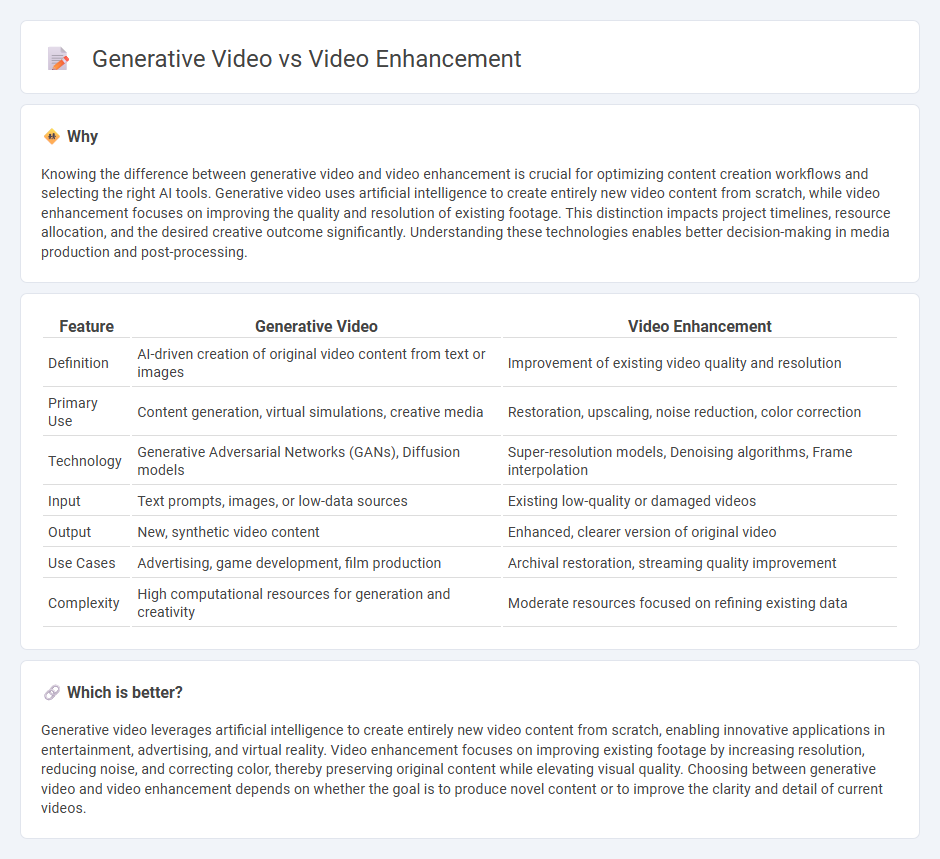
Generative video technology creates entirely new visual content using AI models that synthesize scenes, characters, and motion from scratch, revolutionizing creative production processes. Video enhancement focuses on improving existing footage by applying techniques such as super-resolution, denoising, and frame interpolation to boost clarity and quality. Discover how these cutting-edge technologies reshape digital media and unlock new possibilities.
Why it is important
Knowing the difference between generative video and video enhancement is crucial for optimizing content creation workflows and selecting the right AI tools. Generative video uses artificial intelligence to create entirely new video content from scratch, while video enhancement focuses on improving the quality and resolution of existing footage. This distinction impacts project timelines, resource allocation, and the desired creative outcome significantly. Understanding these technologies enables better decision-making in media production and post-processing.
Comparison Table
| Feature | Generative Video | Video Enhancement |
|---|---|---|
| Definition | AI-driven creation of original video content from text or images | Improvement of existing video quality and resolution |
| Primary Use | Content generation, virtual simulations, creative media | Restoration, upscaling, noise reduction, color correction |
| Technology | Generative Adversarial Networks (GANs), Diffusion models | Super-resolution models, Denoising algorithms, Frame interpolation |
| Input | Text prompts, images, or low-data sources | Existing low-quality or damaged videos |
| Output | New, synthetic video content | Enhanced, clearer version of original video |
| Use Cases | Advertising, game development, film production | Archival restoration, streaming quality improvement |
| Complexity | High computational resources for generation and creativity | Moderate resources focused on refining existing data |
Which is better?
Generative video leverages artificial intelligence to create entirely new video content from scratch, enabling innovative applications in entertainment, advertising, and virtual reality. Video enhancement focuses on improving existing footage by increasing resolution, reducing noise, and correcting color, thereby preserving original content while elevating visual quality. Choosing between generative video and video enhancement depends on whether the goal is to produce novel content or to improve the clarity and detail of current videos.
Connection
Generative video utilizes artificial intelligence to create new video content from scratch or based on existing data, enhancing creative possibilities. Video enhancement employs algorithms to improve video quality by increasing resolution, reducing noise, and refining details. Together, these technologies synergize to produce high-quality, realistic video outputs that are both innovatively generated and visually optimized.
Key Terms
Super-resolution
Super-resolution in video enhancement improves existing footage by increasing resolution, sharpening details, and reducing noise through advanced algorithms and AI models. Generative video leverages AI to create entirely new frames or sequences, often synthesizing high-resolution content by predicting and filling in missing details beyond the original footage. Explore the latest breakthroughs in super-resolution techniques and their applications in both video enhancement and generative video technologies.
Frame interpolation
Frame interpolation enhances video quality by generating intermediate frames to increase frame rate, resulting in smoother motion and improved visual experience. Generative video techniques utilize AI models to create entirely new frames or scenes, enabling more complex transformations beyond simple interpolation. Discover how frame interpolation drives advancements in video playback and content creation.
Text-to-video generation
Video enhancement improves existing footage by refining resolution, color accuracy, and noise reduction to produce clearer and more visually appealing content. Generative video, particularly text-to-video generation, synthesizes new video sequences directly from textual descriptions using advanced AI models like deep learning and GANs, enabling the creation of entirely novel scenes without source footage. Explore the latest advancements and applications in text-to-video generation to understand its impact on media production and content creation.
Source and External Links
Fotor Video Enhancer - Enhance video quality with AI to adjust brightness, contrast, saturation, and more.
VMake AI Video Enhancer - Convert low-quality videos to high resolution like 4K, 30FPS, and more for free.
Topaz AI Video Enhancer - Use AI to enhance video quality, transforming low-res content into high-resolution videos up to 4K.
 dowidth.com
dowidth.com